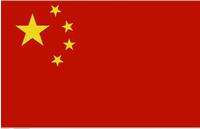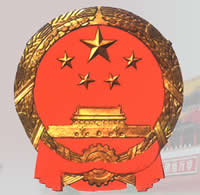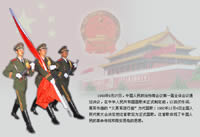|
NATIONAL FLAG, NATIONAL EMBLEM, NATIONAL CAPITAL, NATIONAL ANTHEM|ADMINISTRATIVE DIVISION GEOGRAPHICAL FEATURES|NATURAL RESOURCES|CLIMATE|POPULATION, ETHNIC GROUPS |
|
|
|
NATIONAL FLAG |
| On September 27, 1949, the First Plenary Session
of the Chinese People's Political Consultative Conference (CPPCC) approved
the proposal for using the red five-star flag as the national flag of the
People's Republic of China (PRC). The red color of the flag symbolizes revolution
and the yellow color of the stars the golden brilliant rays radiating from
the vast red land. The design of four smaller stars surrounding a bigger
one signifies the unity of the Chinese people under the leadership of the
Communist Party of China (CPC). |
 |
|
NATIONAL EMBLEM |
| On June 18, 1950, the Second Session of the First
CPPCC National Committee adopted the design and illustration of the national
emblem of the PRC. On September 27 that year, Chairman Mao Zedong ordered
the promulgation of the national emblem. Composed of patterns of the national
flag, the Tian'anmen Rostrum, a wheel gear and ears of wheat, it symbolizes
the New-Democratic Revolution of the Chinese people since the May 4th Movement
(1919) and the birth of New China under the people's democratic dictatorship
led by the working class on the basis of the worker-peasant alliance |
 |
|
NATIONAL ANTHEM |
| On September 27, 1949, the First Plenary Session
of the CPPCC adopted a resolution approving March of the Volunteers, written
by Tian Han and composed by Nie Er, as the temporary national anthem of
the PRC before the formal one was formulated. On December 4, 1982, a session
of the National People's Congress adopted March of the Volunteers as formal
national anthem. The song reflects the revolutionary tradition and the mentality
of vigilance in times of peace of the Chinese people. |
 |
|
NATIONAL CAPITAL |
| On September 27, 1949, the First Plenary Session
of the CPPCC unanimously adopted a resolution making Beiping, renamed Beijing
as of the day, capital of the PRC.
|